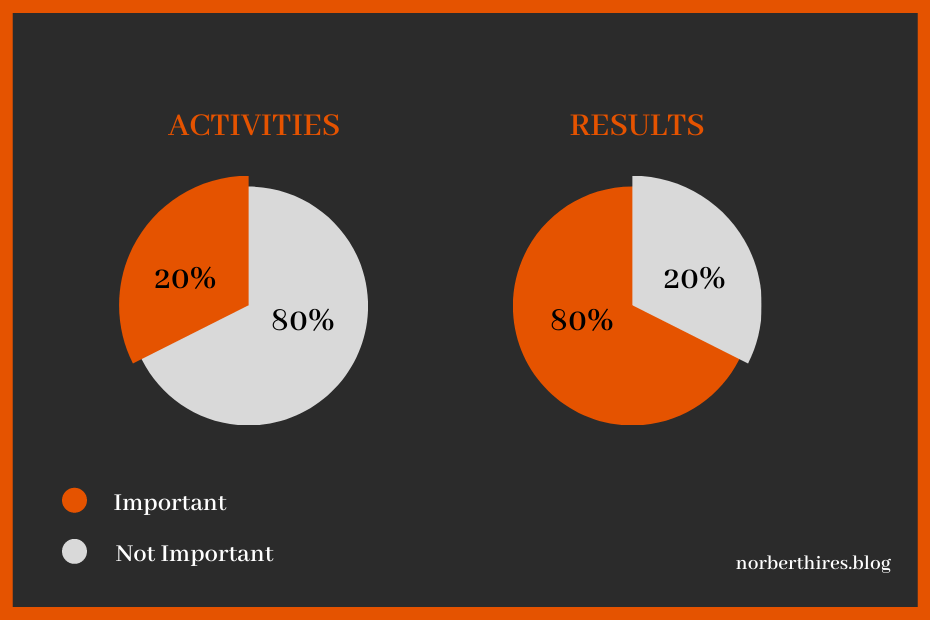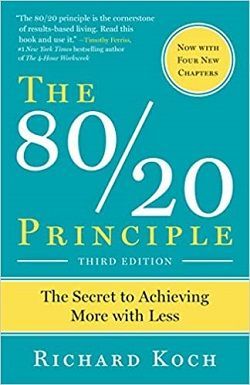Pareto Principle: The 80/20 Rule in Practice
The Pareto Principle helps you identify critical activities, and by leaving out less important tasks you can achieve better results in less time.

However, the rule is not only applicable for time management, as it is based on a much broader phenomenon.
The sensation, also known as the 80/20 rule, is attributed to the Italian economist Vilfredo Pareto. Pareto observed that the distribution of things was unequal, for example in Italy 80% of the wealth was owned by 20% of the population.
The Pareto Principle
According to the Pareto principle, 80% of the outcomes are often caused by 20% of the activities.
Following the principle, we find that in our ten-item to-do list, only two actions are useful to us. We can use the lessons learned to prioritize our tasks, plan our day or week, but also reward our staff, do marketing, develop websites, and many other things.
The Pareto Principle is not a rule set in stone, just an observation.
It doesn't govern nature, we have drawn the conclusions of the 80/20 rule from observing nature. In fact, we are not talking about a universal rule. Maybe in your case, 70/30 or 65/35 is the ratio of activities that contribute significantly to the results and those that fill in. Regardless, applying the principle works great for increasing our efficiency and reducing the time we spend working.

Pareto distribution
The distribution of tasks is not equal, and in some areas, this rule is even more true. You could say that life is unfair.
In areas where the outcome is influenced by human efficiency, you will find that a significant proportion of the results are achieved by just a handful of people.
- 20% of authors write 80% of books sold.
- 20% of staff achieve 80% of the results.
- 20% of customers are responsible for 80% of the revenue.
- 20% of companies contribute 80% of gross domestic product.
Life is not fair because the distribution of things is not equal. Productivity is valued because it is almost the only area we can consciously influence. And the 80/20 rule can help us increase our efficiency.
Why is the Pareto principle useful?
The Pareto Principle helps us to see that the majority of results are caused by a handful of activities. It helps us to prioritize not only our activities but also our relationships, ideas, and learning, among other things.
Applying the Pareto principle
The Pareto principle in time management
More working hours do not necessarily mean better results. But by applying the Pareto principle, we can achieve more in less time. What does this look like in practice? First of all, you should do a Pareto analysis of your day, i.e. apply the 80/20 rule to all your activities.
What are the few things that take up 20% of your day but account for 80% of your results?
Eat the frog
We often procrastinate on the tasks that will produce the biggest results. We tick eight out of ten tasks off our to-do list and then sit back and relax: it's been an efficient day.
Naturally, we start the day with simple tasks. We take out the rubbish, walk the dog.
That's two.
Writing emails, first meeting.
Four.
A small favor, another email, shopping, and cooking.
Tasks were crossed off, but none of them really helped our long-term goals.
If you've managed to find the activities that are responsible for 80% of your results, don't stop at spending more time on these tasks. Start your day with the important tasks so you have the willpower to do them!
Pareto principle for reading and learning
I never understood at university how you could read a long list of required reading for a single subject from one week to the next. I wanted to read all of them, but even if I just read all week, I couldn't get through the maths. However, an anecdote by Richard Koch, author of the most popular book on the Pareto principle, highlighted where I was going wrong.
"My tutor at Oxford used to set me weekly essays and give a long reading list of books and articles. My first reaction was “how can I read all this in a week?” His reply was smooth and fluent: “Read the Conclusion first, then the Introduction, then the End again, then flick through for interesting arguments or examples. For goodness sake, Richard, don’t read the whole bloody thing, except for enjoyment.”
Koch says the Pareto analysis of reading works for all nonfiction books. Why shouldn't we read the required reading material in the same way?

What is the 20% of the curriculum that counts?
When studying for exams, we also encounter the same problem as with compulsory reading: too much material and not enough time.
What to focus on, what to study?
If we want to go through everything, there is no time to deepen our knowledge.
It is also worth applying the 80/20 rule when preparing for an exam.
- What is a subject that has been frequently discussed in previous years? Years, concepts, essay writing?
- Were there any topics that were specifically highlighted by the instructor?
- Are you sure you will need the course material assigned by the guest teacher?
If we target only the questions we are likely to encounter, we will be better off in terms of results than if we have learned everything.
The Pareto principle in marketing
In today's data-driven marketing world, doing Pareto analysis is fairly easy, and with it, even mortals with finite time and resources can achieve results in the online space.
In the case of an online store, it's a legitimate question to ask which 20% of the products bring in 80% of the revenue. If we can answer that question, it makes sense to spend the marketing budget on those revenue-generating products.
Do you sell services online?
Which 20% of your customers are responsible for 80% of your revenue? It might be worth cutting your customers with a different profile.
Of course, it's not always about efficiency and the Pareto Principle doesn't solve everything.
In my case, for example, I could use the 80/20 rule to increase the number of subscribers to my newsletter. I know that list-based posts perform well in search engines and many visitors subscribe when they come to these pages. Based on the Pareto principle, I would only write articles about the best books, best podcasts, and best online courses in the future if my goal was to collect subscribers.
However, the 80/20 rule, in this case, ignores the fact that top-list posts often convince people to subscribe because of the deeper content. Forcing list posts may ultimately reduce the number of subscribers. That's why it's worth analyzing the big picture before imposing Pareto on your life.
The Pareto Principle Book
If you want to learn more about the Pareto Principle, I recommend reading Richard Koch's book The 80/20 Principle: The Secret to Achieving More with Less.
Richard Koch is a business consultant and investor, and in his book, he mainly uses examples from the business world to tell stories that are interesting, while teaching you how to be efficient.
Summary
The Pareto Principle is an economics concept that can be used in everyday life, especially in the field of time management. By continuously analyzing our activities in a Pareto way and making changes in response to experience, we can improve Pareto efficiency and approach the ideal state, the Pareto optimum, according to the principle.
The 80/20 rule can be a useful tool in our hands if we are aware of our motivations and know where we are going. If we are unable to articulate what the expected outcome of an activity is for us, it is worth first developing our self-awareness and clarifying why we bother with our tasks day after day




